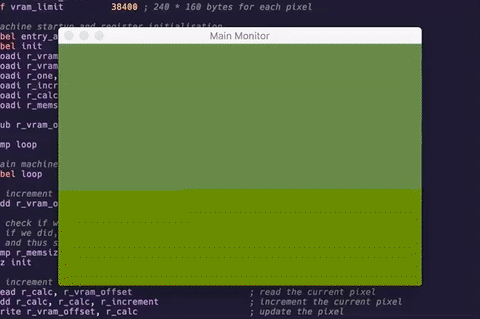Writing a virtual machine
23. April 2017
In the last couple months, my main focus was on writing a virtual machine from scratch. What I wanted was a fully turing-complete machine which would support the following features right out of the box:
- 64-bit floating point calculations
- An implementation of a call stack
- Registers of varying size
- It shouldn’t be slow
- Implement a debugger to step through execution
- Separate process that shows a vram monitor
Besides the actual instruction set, I’ve also created my own version of an assembly language. The syntax of the language is strongly inspired by the AVR assembly language.
Overview
The general principle behind a virtual machine is pretty easy to grasp. What you have is a list of instructions, some registers of a given size and memory. Not all virtual machines have the same amount of registers and not all registers have the same meaning assigned to them.
One of the registers is the ip (Instruction Pointer)
register. It points to the current instruction. At the beginning of each
cycle, the machine reads an opcode from the address pointed to by the
ip register. It then runs the assigned task of that
instruction.
The meaning of each opcode is completly up to the semantic design of the machine. One could assign any meaning to an opcode.
Encoding
The executable format the machine expects is divided into two parts.
+--------------------------------------------------------+
| - Header section |
| |
| magic : ascii encoded NICE |
| entry_addr : initial value of the ip register |
| load_table_size : number of entries in the load table |
| load_table : load table |
+--------------------------------------------------------+
| - Segments section |
+--------------------------------------------------------+Each entry consts of three integers.
+--------------------------------------------------------+
| - Load table entry |
| |
| offset : offset into the executables segments section |
| size : size of the segment |
| address : target address in the machines memory |
+--------------------------------------------------------+Given the following assembly file:
.org 0x500
.label entry_addr
loadi r0, 25
loadi r1, 25
add r0, r0, r1
.org 0x600
.db msg_welcome 11 "hello world"The machine would load the three instructions onto address
0x500 and the "hello world" constant at
address 0x600.
Registers
Available registers:
r0 - r59General purpose registersipInstruction pointerspStack pointerfpFrame pointerflagsFlags register
The machine’s registers are able to hold a 64-bit value. By default
however, only the lower 32-bits are targeted. The below code reads 16
bytes from a buffer at 0x500 and writes each
dword into the registers r0 to
r3. It also demonstrates the automatic label resolution and
offset calculation features in the assembler.
.def BUFFER_SIZE 16
.label entry_addr
readc r0, (buffer + 0)
readc r1, (buffer + 4)
readc r2, (buffer + 8)
readc r3, (buffer + 12)
.org 0x500
.db buffer BUFFER_SIZE 0Virtual Display
The last 38’800 bytes in memory are reserved for VRAM. The monitor
process, which is also built into the vm, displays the contents of this
area in memory in color. The monitor supports 255 different
colors. A single byte encodes the color of a single pixel as
rrrgggbb.

Roadmap
In the months to come, I want to focus on writing some built-in methods for doing graphics stuff. I’d also like to experiment with writing a simple compiler to be able to use a subset of C on my vm.
I’m open for contributions of any kind and I’d love to get some feedback on the design of my vm.
The repository is on GitHub at github.com/KCreate/stackvm and is licensed under the MIT license.
Copyright © 2024 Leonard Schütz | Attributions